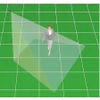Open source subdivision modeler available for Windows, Linux and OS X
Open source subdivision modeler available for Windows, Linux and OS X
Pros
- Compatible with several major design platforms for model import
- Expansive toolset for polygonal modeling and subdivision surfaces
- Extensive customization options for interface and workflow
- Continuous improvements with new features and bug fixes
- Comprehensive tutorials available for beginners
Cons
- Lacks native tools for creating models from scratch
- Potentially steep learning curve for newcomers to 3D modeling
- Focuses mainly on modeling, with no animation or advanced rendering tools
Wings 3D: A Versatile Subdivision Modeler for Design Professionals
Introduction to Wings 3D
Wings 3D stands as a proficient 3D modeling tool, tailored primarily for importing and refining models through the use of subdivision surfaces—a technique pivotal in generating smooth, high-quality polygons. This program serves as a bridge between the creation of basic polygonal forms and their transformation into intricate 3D models.
Functionality and Importing Capabilities
Although Wings 3D does not boast native tools for crafting models from the ground up, its strength lies in the robust manipulation of existing models. Designers can import assets from a variety of leading design platforms, including 3D Studio, Adobe Illustrator, and LightWave. Once imported, these models can be effortlessly converted into polygonal meshes, which users can then sculpt with precision using subdivision polygons.
Toolset and Development Features
The software is equipped with a comprehensive array of tools that facilitate the addition of materials, textures, and UV coordinates to models. It also offers functionalities to embed lights into scenes and capture screenshots, among other features. Notably, Wings 3D includes advanced options such as Plane Cut, Slice, Rotate Unconstrained, and Sculpt Mode, allowing for extensive manipulation and fine-tuning of models.
Usability
For individuals fresh to 3D modeling or unfamiliar with polygonal design, Wings 3D may pose a challenging learning curve. Nevertheless, for seasoned artists, the complexity is balanced by the program's powerful capabilities. To bridge the knowledge gap, Wings 3D's website provides a detailed tutorial guiding users from their initial model import through successive stages of modeling.
Interface and User Experience
The program has seen substantial developments in its interface, with an emphasis on improving user experience and productivity. Wings 3D now supports Asian fonts for Chinese, Japanese, and Korean users, incorporates roll-up windows, and introduces a Menu Toolbar for right-click menus. The Geometry Graph has been enhanced with folders and refreshed icons.
Users can personalize their workspace with four different color themes found in the Edit menu. Preferences can be saved and loaded for convenience, and long menus are automatically clipped for better navigation. A notable addition is the Tweak Palette, which streamlines the selection of Tweak tools, magnets, and axis constraints.
Performance and Improvements
The major rewrite of the Tweak feature is a testament to Wings 3D’s commitment to constant enhancement. This update introduces heightened performance, added flexibility, and new tools that significantly refine the modeling process.
Wings 3D has also concentrated on ironing out existing bugs and fortifying the stability of the platform. For instance, there is now a fix that ensures the maximized Wings layout is correctly restored on Windows systems, addressing a common issue faced by many users.
Conclusion
Overall, Wings 3D emerges as a formidable tool for serious designers who require a potent software for the refinement of models created in other renowned 3D design environments. While the application demands a certain level of expertise to fully exploit its potential, the diverse set of features makes it a valuable asset in the repertoire of any professional 3D artist or designer.
Pros
- Compatible with several major design platforms for model import
- Expansive toolset for polygonal modeling and subdivision surfaces
- Extensive customization options for interface and workflow
- Continuous improvements with new features and bug fixes
- Comprehensive tutorials available for beginners
Cons
- Lacks native tools for creating models from scratch
- Potentially steep learning curve for newcomers to 3D modeling
- Focuses mainly on modeling, with no animation or advanced rendering tools




